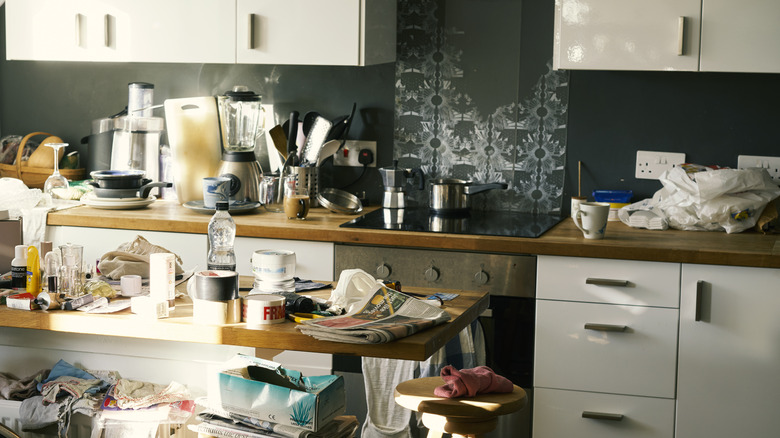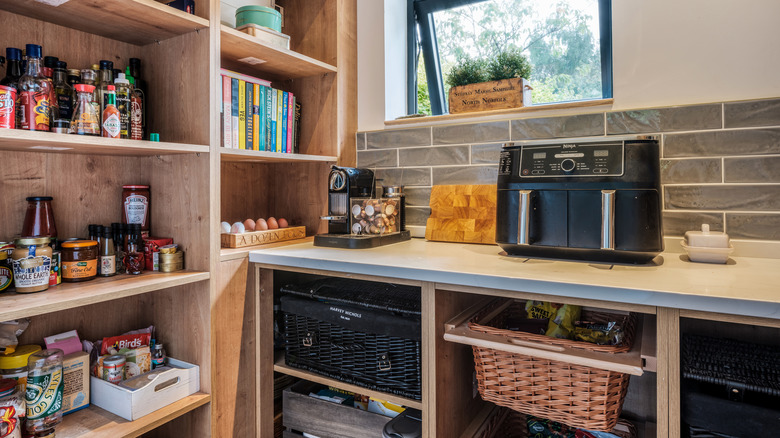The Old-School Kitchen Addition That Keeps Modern Messes Hidden
While modern advancements in home design offer plenty of perks, sometimes the best solutions come from looking to the past. Certain features, once staples of traditional kitchens, remain just as charming and practical today as they were back then. We're not just seeing unexpected '90s design trends that are making a bold comeback, but also some functional designs from earlier centuries resurfacing as traditional styles continue to rise in popularity. As time goes by, our kitchen spaces seem to get more and more cluttered with the newest necessities, leaving less room for food and everyday items. While color-coded storage seems like the answer, its main function is to organize, so your clutter might look prettier, but it won't be hidden. Instead, you may want to consider keeping messes out of sight with the kitchen addition that hails from the 1900s — a larder.
A larder was a small room or cabinet used to store perishable foods like meat, cheese, and veggies before fridges were common, and they were typically placed in a shaded part of the house to keep things cool. In today's world of Bluetooth refrigerators and central air conditioning, it's not surprising that larders were eventually phased out of kitchen floor plans. However, looking at larders with a modern lens might also allow us to see them with a new purpose, like storing clutter. This might be a solution worth exploring, and there are plenty of ways to build a larder into your current home design.
Use a larder to hide kitchen clutter
Kitchen pantry renovations are trending for 2025, and with that may come the idea of a potential larder addition to take things to the next level. The modern larder has homeowners taking advantage of contemporary materials, shapes, and decor to give this kitchen addition a whole new edge. At its core, the perfect larder is a small, cool space for storage with ventilation, so it doesn't necessarily need an entire dedicated room. However, if you dedicate a room to your larder, this gives you extra room to hide larger messes like unwashed dishes or half-empty containers for a short period, just in case someone decides to drop by last minute and you need to tidy surfaces quickly and deal with the mess you hid later on.
If you want to stick with its original purpose, use a larder to store overflow items you might commonly keep in the fridge, like dairy, as long as you're sure the temperature of the space is accommodating by removing any direct sunlight or heating from the space. You could also make it feel more modern by using the space as storage for servingware, jars of sauce, or clunky electronics like that bread machine you only dust off for special occasions. This can also be an ideal space to store those perfectly organized bins of dry goods that look neat but take up too much space on your countertops and in your pantry.
How to build a larder into your home design
If you're starting a kitchen renovation from scratch and the idea of a larder seems appealing, there are many ways to include it in your design. You could incorporate a larder inside your kitchen island to keep your storage in the same space with less visibility, or you might create a small room to keep it traditional. For a larder in the kitchen, you can tuck the larder shelves behind large glass doors with privacy windows to keep clutter out of sight — these shelves could vary as anything from floor-to-ceiling cupboards to a freestanding storage space that has its own countertop. You can even bring large cupboards with pull-out racks for appliances and spices into a walk-in pantry design to create a space-saving larder. If you are working within a pantry space, consider creative DIY pantry ideas to expand your kitchen storage to ramp up the overall organization.
If you plan to build a walk-in larder like some old-school designs, lighting and temperature are crucial. A larder calls for cool temperatures, so materials like natural stone or slate can be worth extra costs to keep things cool, and air bricks can help provide proper ventilation. It's also helpful to keep things dark with a windowless design and use LED lights for energy efficiency and less heat emission. Once you have the practical layout planned, you can get creative with decor to truly bring your larder space into the modern age.

